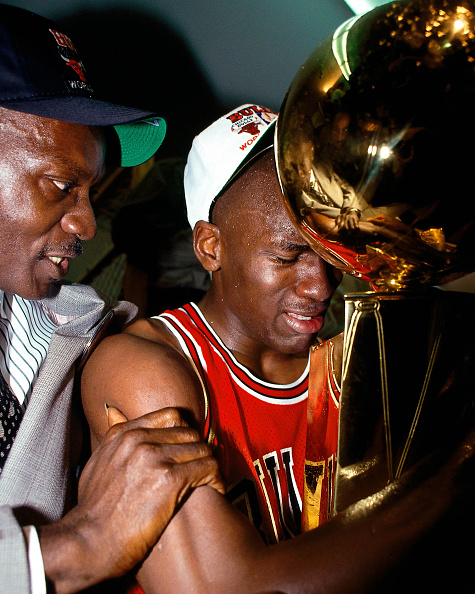Winning is everything for athletes. After years — or for some, decades — of grueling training, it’s the culmination of their dedication. “I trained four years to run nine seconds, and people give up when they don’t see results in two months,” Usain Bolt famously said. To have the maniacal devotion required to become a champion is part of what it means to be great. It’s superhuman — like Bolt, who won eight Olympic medals in track and field and still holds the world records in the 100-meter and 200-meter sprints he set in 2009.
There’s a reason triumphs like his come with something to hold. A trophy is a symbol used to celebrate a win that outlasts the moment. It also shapes how fans remember sports icons forever. “A great trophy should be something a player can hug, cry over, celebrate with — it should physically embody victory,” said Victoria Reynolds, Tiffany & Co.’s chief gemologist and vice president of high jewelry acquisition. “It needs to be as iconic as the moment it’s part of.”
Like when 17-year-old Serena Williams, brimming with youthful insouciance, kissed the trophy at the 1999 US Open, having just become the first Black woman to win a Grand Slam singles title in the Open Era. Or the moment Kobe Bryant was handed the Larry O’Brien Trophy after clinching the 2001 NBA Finals. And when Michael Jordan collapsed in the locker room, hugging the gold-plated trophy from his first NBA Championship with the Chicago Bulls in 1991.
These modern images of glory all share one thing: hardware crafted by Tiffany & Co. Here, we take a look at the history of lifting a prize in triumph, dating back to the earliest arenas of sport, and how (and where) the glory of the moment merged with the jewelry maker of note.

From Wreaths to Sterling Silver
The first instance of trophies given out to winning athletes dates to Ancient Greece, in 776 BCE. Champions of the original Olympic Games were crowned with a kotinos — a wreath of wild olive branches cut from Zeus’s sacred grove in Olympia. Over time, they gave way to sculpted objects cast in silver and gold, precious tokens embodying prestige. By the mid-19th century, silversmiths like Rundell Bridge & Rundell — and later Garrard & Co., the crown jewelers of London — turned trophies like the America’s Cup into the gleaming symbols of victory they remain today.
But no name is more tied to sports’ biggest prizes — the US Open, NBA, NFL and MLB — than Tiffany & Co. Founded in 1837, during the Gilded Age, by Charles Lewis Tiffany, the jeweler started out creating trophies for yachting and thoroughbred horseracing events. To this day, it still makes two of the three Triple Crown prizes: the Woodlawn Vase and the Belmont Memorial Challenge Cup.
By 1851, it introduced the English sterling silver standard of 92.5% purity for its silverware, at a time when benchmarks for quality were inconsistent. It was later adopted as the United States’ sterling standard. This meant, “any Tiffany & Co. trophy will be stamped ‘Tiffany Makers’ and ‘925,’” said Reynolds. “You can flip a piece of our hollowware and know the exact year, the silversmith and even the alloy composition. It’s like a little treasure map in metal.”

From Sterling Silver to Memory-Maker
“It all starts with the league or sport. We go through months of design ideation to capture what makes that sport iconic,” explained Reynolds. “Once the design is locked in, the technical process begins — and honestly, that part hasn’t changed much in nearly 200 years.”
The NFL’s sterling silver Vince Lombardi Trophy begins as flat sheets that are spun on a lathe, annealed to stay malleable, then soldered, hand-chased for texture and precision-polished before given a final engraving and live post-game inscription by a master artisan. “That entire process takes four to six months, with about six expert artisans working on each one,” said Reynolds.
Victor Solomon, who worked with Tiffany to reimagine the Larry O’Brien Trophy in 2022 for the NBA’s 75th anniversary, honored the past while evolving the design to reflect the present — and prepare for the future. Put one way, he helped design it to hold more memories. “I approached it with a 25-year time horizon in mind,” Solomon said. Previously fully gold-plated, the trophy now features exposed sterling silver seams and netting to add contrast and definition in photos and media. The rectangular base is a double-stacked disc engraved with the names of past champions, but it also has space to hold 25 years’ worth of future winners. “It became a time capsule, sort of, for posterity, of previous champions that carry on the legacy with each growing year, and then at the 100th anniversary, you know, maybe we’ll redesign everything again.”

An Object Worth Its Weight in Effort
Trophies may be made of silver and gold, but their real value lies in what they represent. For the athletes and teams who earn them, they mark the end of a season — and the culmination of years of effort, sacrifice and discipline.
“Sport is so interesting because it’s kind of the only clean meritocracy we have in society,” said Solomon. “You can’t just be friends with the commissioner and get to the championship — you really have to go to battle to get to the mountains.” He believes the trophy, the object that marks the end of that journey, should reflect the rigor of the players who earned it.
This belief is shared by Tiffany’s artisans, who treat each commission as a mission to record effort, teamwork and the sport as a whole. At its core, Reynolds said, “victory is when a group of individuals come together and do something extraordinary. That’s what each of these trophies is built to represent.”

